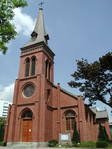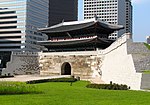Seoullo 7017

Seoullo 7017 (Korean: 서울로 7017), also known as the Seoul Skygarden or Skypark, is an elevated, linear park in Seoul, built atop a former highway overpass. The path, which is about one kilometer in length and lined with 24,000 plants, is similar to New York City's High Line. Skygarden was designed by MVRDV, a Dutch firm, and opened in May 2017. In the future, the park may become an urban nursery, growing trees and plants for replanting elsewhere in the city. The path also improves walking times around the city's Central Station.The disused overpass closed in 2015 and cuts diagonally across Seoul Station at 17m above street level. The '70' in the name comes from the year 1970 when the flyover was dedicated, while the '17' is both the number of walkways connected to it, and the year 2017. The park includes gardens, terraces, and exhibitions, and will "feature over 24,085 plants representing 228 species of trees, shrubs and flowers found in and outside Korea."
Excerpt from the Wikipedia article Seoullo 7017 (License: CC BY-SA 3.0, Authors, Images).Seoullo 7017
Seoullo 7017, Seoul Hoehyeon-dong
Geographical coordinates (GPS) Address Website Nearby Places Show on map
Geographical coordinates (GPS)
| Latitude | Longitude |
|---|---|
| N 37.5567 ° | E 126.9716 ° |
Address
문화역서울284 (구서울역사)
Seoullo 7017
04509 Seoul, Hoehyeon-dong
South Korea
Open on Google Maps







